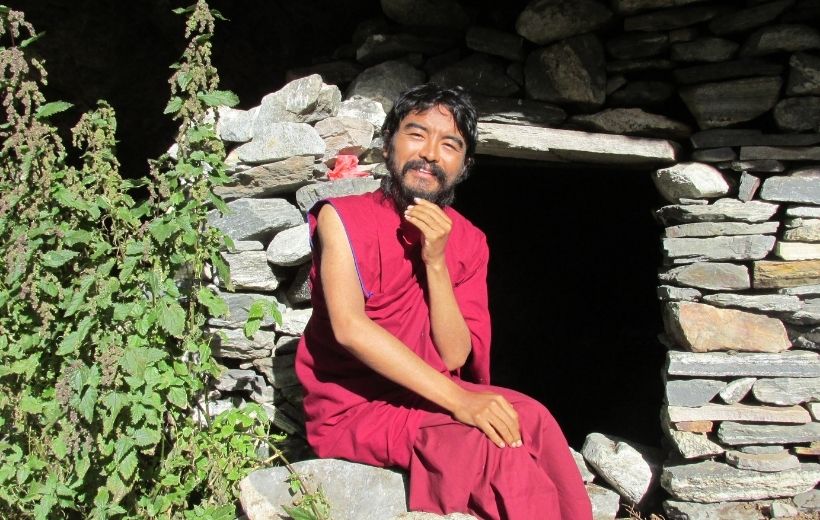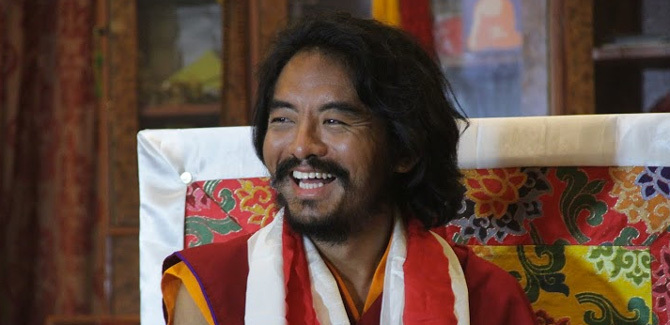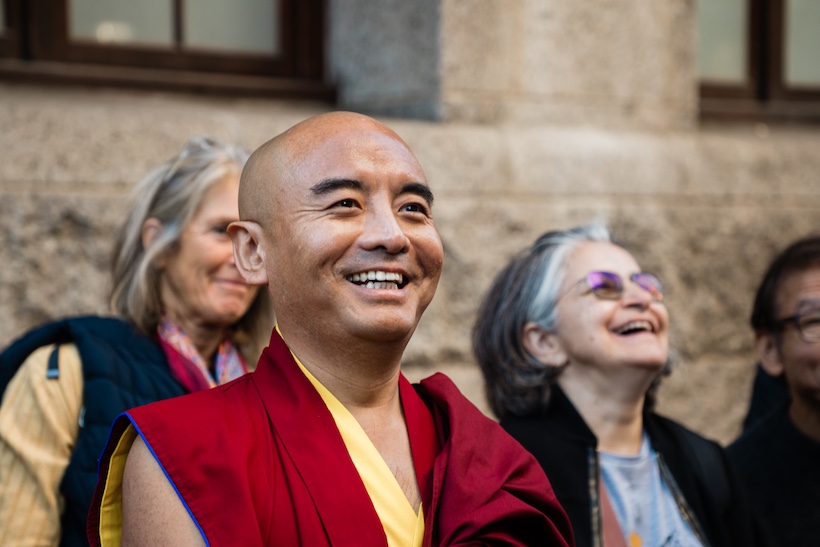Ten Years Ago: Rinpoche Returns From Wandering Retreat
By Franka Cordua-von Specht • 4 min read
By Franka Cordua-von Specht • 4 min read

TEN YEARS AGO, on November 10, 2015, a phone call rippled through the Tergar community: “He’s back. Mingyur Rinpoche has come out of retreat.”
For four and a half years, Rinpoche had disappeared into the mountains of Nepal and the plains of India on a traditional wandering retreat, leaving behind his growing international community and four Tergar instructors — Cortland Dahl, Edwin Kelley, Myoshin Kelley, and Tim Olmsted — charged with developing Tergar International. He had left his Bodhgaya monastery in June 2011, leaving a farewell letter to his students.
“I had asked him, ‘Rinpoche, when are you coming back?’” said Tim, “And he said, ‘I can’t tell you that.’” Similarly, he’d told Cortland Dahl it would be “at least three years, possibly five, and maybe much longer.”
Rinpoche’s departure in 2011 followed an intense period of teaching that gave the nonprofit a financial cushion and a mandate. Still, each year the surplus dwindled as the team poured their energy into building communities, training leaders, and launching the first Joy of Living online courses.
The news came when Tim was in a restaurant in Colorado, Cortland was at the University of Wisconsin-Madison, and Edwin Kelley was about to teach a class on the life of the Buddha when the call came through.
It was a Tuesday evening when Edwin’s phone rang — an unexpected call from Lama Khenpo Kunga. “He’s back,” Khenpo said simply. “Rinpoche has come out of retreat.”
“I felt incredible joy and relief,” said Edwin, then-executive director. “I had been waking up at four in the morning, worrying about how to keep Tergar going. Suddenly, all those worries evaporated.”
“I’d love to say I had some prophetic dream or intuitive sense that he was about to return, but I had absolutely no clue,” said Cortland, who was balancing work on his doctorate with developing Tergar. “I was overjoyed.”
Almost overnight, the instructors were on planes to Delhi, and it would be an incredibly magical week.

“His eyes were on fire, and he was joyful and playful.” — Edwin Kelley
First Glimpse
By Friday, the instructors were in Delhi, eager for their first meeting. “I couldn’t wait to see him, to hear about his retreat, and to see whether something in him felt different after all that time away,” said Cort.
Their first glimpse was unforgettable. “He was both utterly ordinary and completely extraordinary — so light on the planet,” recalled Myoshin.
He was thin, with long hair and a beard. “He was skinny as a rake. He didn’t cast a shadow,” Edwin said, “but he was bright as a beacon. His eyes were on fire, and he was joyful and playful.”
He asked immediately about Tergar’s progress. “He was actually excited to know that Tergar had survived!” Edwin said. Before leaving, Rinpoche had filmed the raw footage for Joy of Living Level 2 but hadn’t seen the completed course. When Edwin opened his laptop, Rinpoche smiled. “Oh,” he said simply, “so it was useful.”
“In his absence, he’d gotten more and more students,” said Myoshin. “That’s quite a capacity for someone away on retreat.” He also instantly grasped how technology had changed. “He’d just been in an airport and noticed everyone on their phones.” After years wandering through forests, cities, caves, and villages, he adapted effortlessly to the digital landscape.
Sherab Ling
Soon after, the instructors flew with Rinpoche to Dharamsala and then drove to Sherab Ling Monastery, home of Tai Situ Rinpoche, one of his four root teachers. “As we came down the last stretch of road,” Edwin recalled, “it was lined with people playing horns and cymbals and offering khatas, welcoming him home.”
Inside the monastery, Mingyur Rinpoche made the traditional offerings of body, speech, and mind. “It was incredibly moving,” said Tim. “Tai Situ Rinpoche was worried that Mingyur Rinpoche had lost so much weight. He was fussing about him, like a proud dad. This was his son coming home.”
After their reunion, Tai Situ Rinpoche turned to the Western instructors and offered a direct teaching. “He reminded us that it was now our responsibility to preserve the integrity of the authentic buddhadharma when propagating it to the Western world,” Edwin said. “He said, in essence, ‘Don’t screw it up!’ It was unforgettable.”
Over the following days, visitors formed a steady stream outside Rinpoche’s quarters, and he taught to a full monastery. The instructors spent time with him in his intimate, small room, including during the lighthearted moment when he shaved his long beard and hair. “He was clowning the whole time,” Edwin said. “He shaved half the beard, left the other side, and kept posing with a lot of hilarity in the room.”
Rinpoche also demonstrated the awareness yoga sequence he had developed on retreat, and the instructors requested practices. Tim asked for a smoke offering, and Myoshin for a White Tara sadhana. He penned both.
And always, there was his presence. “You couldn’t help but be impacted by his presence in a quite profound way,” said Edwin. Rinpoche shared details of his near-death experience — later recounted in In Love with the World and Paul MacGowan’s film Wandering… But Not Lost. “He was trying to articulate to us the difference in his perception before his near-death experience, and then afterwards.”
“It was obviously an incredibly profound transformation. He kept trying to find the right language,” said Edwin. “It’s like the trees were love, which is that remarkable sentence in his book.”
The Rinpoche they had known before the retreat had changed. “He was more relaxed, more grounded,” Tim said. “Just aged, but aged in a timeless way.”
“It was the same Mingyur Rinpoche,” said Myoshin, “but completely natural, unguarded, effortless.” She recalled filmmaker Paul MacGowan’s words: “He’s the same, only more so!”
“He owned his independence!” said Edwin. Whether traveling alone or disappearing off-grid for days at a time, he managed his conditions with ease. “One time, he said he wanted to go to Bolivia, and all I did was buy him a ticket. After that, he would go off grid, and I wouldn’t hear from him until he was back.”
The Surprise—and the Significance
In some ways, Rinpoche’s departure in 2011 had been unexpected, though he had occasionally spoken about Nyoshul Khyen Rinpoche, who was known as a wandering yogi. But the timing was extraordinary. “Students were starting to flock to him,” said Myoshin. “He set it all up, and then let it go!”
“Imagine starting a brand-new organization and then having your CEO disappear on a five-year sabbatical,” Cort said. The team managed well, but by the fifth year, they wanted his vision and direction.
“The bigger impact was on the community. It’s still amazing to me that the community didn’t fall apart while he was gone. If anything, it grew, which I see as a sign of his blessings more than anything we did. But it was getting harder. People were feeling his absence,” he said.
When Rinpoche returned, “he brought a burst of energy at a moment when ours was starting to dip,” Cort said. “He was overflowing with ideas and new inspiration.”
“Having him back as the guiding light — for both the community and the organization — was huge. The fact that we held things together for five years without him is, in a way, a testament to his leadership. But his return couldn’t have come at a better time.”
Cort noted that wandering yogi retreats were once common in Tibet but have almost vanished in the modern era, especially for prominent teachers. “The fact that he not only did this retreat, but did it in such a radical way, is extraordinary,” he said. “And the fact that he did it while being a globally recognized teacher, with bestselling books and a huge following, makes it even more remarkable. He had every reason not to go… He went anyway.”
“To me, that was an act of real courage and commitment, and also an act of generosity toward the lineage and toward future generations,” he said. “I’m sure it will play a lasting role in keeping this lineage alive and vibrant long into the future.”
November 2025

Tergar Instructors Cortland Dahl, Tim Olmsted, Edwin Kelley, Mingyur Rinpoche, Myoshin Kelley at Delhi airport.
The Rinpoche they had known before retreat had changed. “He was more relaxed, more grounded,” Tim said. “Just aged, but aged in a psychic, cosmic way.”
“It was the same Mingyur Rinpoche,” said Myoshin, “but completely natural, unguarded, effortless.” She recalled filmmaker Paul MacGowan’s: for the first time, “It’s just like he became more of who he really is.”
“He owned his independence!” said Edwin. Whether traveling alone or disappearing off-grid for days at a time, he managed his conditions with ease. “One time he said he wanted to go to Bolivia—and all I did was buy him a ticket. After that he would go off grid and I wouldn’t hear from him until he was back.”
In some ways, Rinpoche’s departure in 2011 had been unexpected, though he had occasionally spoken about Nyoshul Khyen Rinpoche, who was known as a wandering yogi. But the timing was extraordinary. “Students were starting to flock to him,” said Myoshin. “He set it all up, and then let it go!”
“Imagine starting a brand-new organization and then having your CEO disappear on a five-year sabbatical,” Cort said. The team managed well, but by the fifth year they were wanting his vision and direction.
“The bigger impact was on the community. It’s still amazing to me that the community didn’t fall apart while he was gone. If anything, it grew — which I see as a sign of his blessings more than anything we did. But it was getting harder. People were feeling his absence,” he said.
When Rinpoche returned, “he brought a burst of energy at a moment when ours was starting to dip,” Cort said. “He was overflowing with ideas and new inspiration.”
“Having him back as the guiding light — for both the community and the organization — was huge. The fact that we held things together for five years without him is, in a way, a testament to his leadership. But his return couldn’t have come at a better time.”
Cort noted that wandering yogi retreats were once common in Tibet but have almost vanished in the modern era—especially for prominent teachers. “The fact that he not only did this retreat, but did it in such a radical way, is extraordinary,” he said. “And the fact that he did it while being a globally recognized teacher, with bestselling books and a huge following, makes it even more remarkable. He had every reason not to go… He went anyway.”
“To me, that was an act of real courage and commitment, and also an act of generosity toward the lineage and toward future generations,” he said. “I’m sure it will play a lasting role in keeping this lineage alive and vibrant long into the future.”
November 2025

Franka Cordua-von Specht, co-founder of the Tergar Vancouver Practice Group and Tergar Canada, contracts for Tergar International’s marketing and communication team. She is a Tergar Guide and facilitates Joy of Living workshops.
Learn meditation under the skillful guidance of world-renowned teacher Yongey Mingyur Rinpoche at your own pace.


Mingyur Rinpoche’s 2025 visit to South Africa brought together decades of Buddhist practice and fresh inspiration for a growing meditation community.

Tergar Guide Maria Primachenko shares her journey from an intense advertising career to a healthier work-life balance, emphasizing self-care, mindfulness, and letting go of the need to act on every idea or be constantly heroic. Guided by Mingyur Rinpoche’s teachings, she highlights the importance of living in the present moment, embracing change, and trusting intuitive…

For first-year university student Tshepo Molekwa, meditation has become more than just a stress reliever — it’s a way to stay grounded, make wiser choices, and bring deeper meaning into student life.
If you enjoyed reading our articles, please join our mailing list and we’ll send you our news and latest pieces.